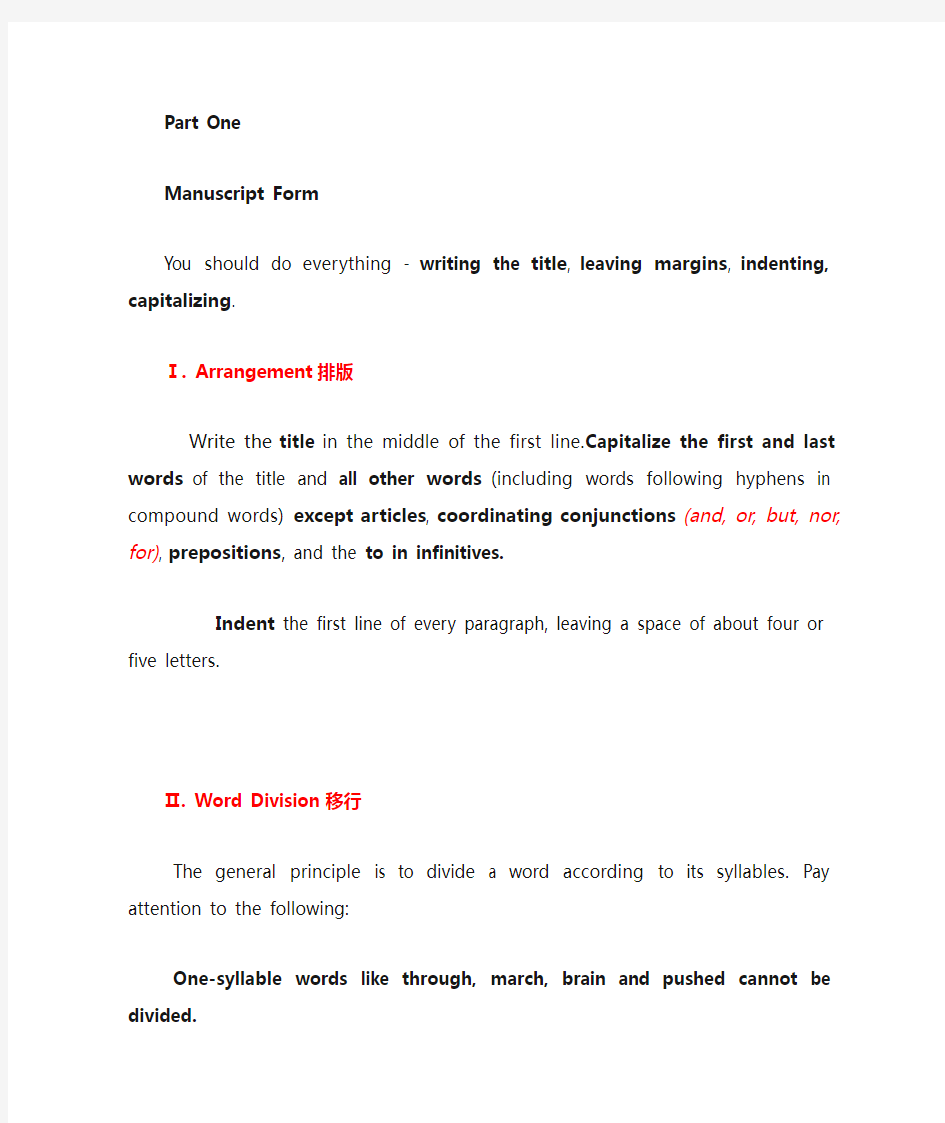英语写作手册 英文版 知识点

- 1、下载文档前请自行甄别文档内容的完整性,平台不提供额外的编辑、内容补充、找答案等附加服务。
- 2、"仅部分预览"的文档,不可在线预览部分如存在完整性等问题,可反馈申请退款(可完整预览的文档不适用该条件!)。
- 3、如文档侵犯您的权益,请联系客服反馈,我们会尽快为您处理(人工客服工作时间:9:00-18:30)。
Part One
Manuscript Form
You should do everything - writing the title, leaving margins, indenting, capitalizing.
Ⅰ. Arrangement排版
Write the title in the middle of the first line. Capitalize the first and last words of the title and all other words(including words following hyphens in compound words) except articles, coordinating conjunctions(and, or, but, nor, for), prepositions, and the to in infinitives.
Indent the first line of every paragraph, leaving a space of about four or five letters.
Ⅱ. Word Division移行
The general principle is to divide a word according to its syllables. Pay attention to the following:
One-syllable words like through, march, brain and pushed cannot be divided.
Do not write one letter of a word at the end or at the beginning of a line, even if that one letter makes up a syllable, such as a. lone, trick. y.
Do not put a two-letter syllable at the beginning of a line, like hat. ed, cab. in.
Avoid separating proper names of people or places, like Chi. na, Aus. ten.
Divide hyphenated words only at the hyphen: father-in-law, empty-handed. Do not divide words in a way that may mislead the reader: pea. cock, re. ally.
Do not divide the last word on a page. Instead, write the whole word on the next page.
Divide words with prefixes or suffixes between the prefix or suffix and the base part of the word: re. state. ment, un. relent. ing.
Divide two-syllable words with double consonants between the two consonants: strug. gle, shat. ter.
Dividing words is not always easy. When in doubt, consult a dictionary
Ⅲ. Capitalization大写
Capitals are used mainly at three places: the first words of sentences, key words in titles, and proper names.
Ⅳ. Punctuation标点
V. Handwriting书法
Write carefully so that your handwriting can be read easily.
Part Two
Diction措词
Ⅰ. Levels of Words词的类型
The words that are often used may be divided, from a stylistic point of view, into three types: formal, common, and informal.
Formal words may also be called learned words, or literary words, or "big" words. They mainly appear in formal writing, most of them are seldom used in daily conversation, except for special purposes.
those that people use every day, and appear in all kinds of writing., they are called common words.
There are words which are mainly used in informal or familiar conversation. They seldom appear in formal writing, and in literary works their main use is to record people's thoughts and dialogues. They are usually short words of one or two syllables and most of them are of Saxon origin We may call them informal words
Slang words are highly informal; they may be vivid and interesting, but they may, when used inappropriately, make the writer or speaker sound offensive or funny
Ⅱ. The Meaning of Words词义
The meaning of a word has two aspects: denotative and connotative. A word's denotation is what it literally means, as defined by the dictionary; its connotation is the feeling or idea suggested by it.
Ⅲ. General and Specific Words泛指词和特指词
Specific words help to make writing clear, exact, vivid, and striking, for they are more informative and expressive than general words.
Ⅳ. Idioms习语
An idiom is a fixed group of words with a special meaning which is different from the meanings of the words that form it.
Idioms are frequently used in speech and writing. They help to make one's language sound natural and idiomatic.
Ⅴ. Figures of Speech修辞
Words used in their original meanings are used literally, while words used in extended meanings for the purpose of making comparisons or calling up pictures in the reader's or listener's mind are used figuratively.
1. Simile明喻It is a comparison between two distinctly different things and the comparison is indicated by the word as or like.
2. Metaphor暗喻It is the use of a word which originally denotes one thing to refer to another with a similar quality.
3. Personification拟人It is to treat a thing or an idea as if it were human or had human qualities. In poetry personification is very common:
In prose personification is also used, though not so often as in poetry.
4. Metonymy转喻It is substituting the name of one thing for that of another with which it is closely associated.
5. Synecdoche提喻When a part is substituted for the whole or the whole is substituted for a part, synecdoche is applied
